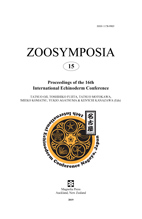Abstract
The Caribbean is considered a unique biogeographic region that represents an important hotspot of marine diversity in the Atlantic Ocean. The Caribbean Continental Slope of Central America (CCCA) is a largely unexplored area that exhibits a variety of habitats. Among this unstudied biodiversity, special importance has been given to the benthic communities associated with deep bottoms, a diverse group that plays a major role in the ocean carbon cycling and nutrient flux. Echinoderms are one of the main benthic deep sea taxa, in which Holothuroidea is the globally dominant class. We present the results from the first exploratory fishing survey campaign on the CCCA, done under the regional coordination of OSPESCA (Central America Fisheries and Aquaculture Organization) on board of the R/V Miguel Oliver in January 2011. Data was collected from a total of 96 trawls arranged in 25 transects that started in Panama and finished in Belize. A Lofoten bottom trawling net was dragged for 30 min between 0 to 1500m depth. The major component of the total invertebrate catch was Holothuroidea with a biomass of 593 kg (16.49% of the total) and represented by seven species. The following are new reports for the Caribbean: Bathyplotes natans in Honduras and Guatemala, Bentothuria funebris in Panama, Benthodytes sanguinolenta in Panama, Costa Rica, Nicaragua and Belize; Hansenothuria sp. in Panama, Costa Rica and Honduras. Paroriza pallens extends its distribution to Panama, Costa Rica, Nicaragua and Honduras, Zygothuria lactea its reported in Panama. We also present the first records of the crinoid Neocomatella pulchella in Honduras, theasteroid Cheiraster (Cheiraster) planusin Panama, and, for Costa Rica (Asteroidea: Doraster constellatus and Echinoidea: Clypeaster euclastus).Holothurians are the predominant invertebrate fauna in terms of biomass in the entire region of the CCCA. These findings suggest that CCCA presents a high echinoderm biodiversity and also supports the ecoregional variation theory. We report higher echinoderm biomass (75%) in the Southwestern Caribbean compared to Western Caribbean ecoregion. The information presented in this paper establishes the baseline information of echinoderms depth fauna in the Caribbean of Central America, and opens new opportunities for future research.

